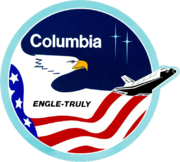STS-2

Columbia on the launchpad
|
|
| Mission type | Test flight |
|---|---|
| Operator | NASA |
| COSPAR ID | 1981-111A |
| SATCAT no. | 12953 |
| Mission duration | 2 days, 6 hours, 13 minutes, 12 seconds |
| Distance travelled | 1,730,000 kilometres (1,075,000 mi) |
| Orbits completed | 37 |
| Spacecraft properties | |
| Spacecraft | Space Shuttle Columbia |
| Launch mass | 104,647 kilograms (230,707 lb) |
| Landing mass | 92,650 kilograms (204,260 lb) |
| Payload mass | 8,517 kilograms (18,777 lb) |
| Crew | |
| Crew size | 2 |
| Members |
Joe H. Engle Richard H. Truly |
| Start of mission | |
| Launch date | 12 November 1981, 15:09:59 UTC |
| Launch site | Kennedy LC-39A |
| End of mission | |
| Landing date | 14 November 1981, 21:23:11 UTC |
| Landing site | Edwards Runway 23 |
| Orbital parameters | |
| Reference system | Geocentric |
| Regime | Low Earth |
| Perigee | 222 km (138 mi) |
| Apogee | 231 km (144 mi) |
| Inclination | 38.03 degrees |
| Period | 89.0 minutes |
 Engle (left) and Truly |
|
STS-2 was the second Space Shuttle mission conducted by NASA, and the second flight of the orbiter Columbia. The mission launched on 12 November 1981 and landed two days later on 14 November. STS-2 marked the first time in history that a manned, reusable orbital vehicle returned to space for a second time. This mission tested the Shuttle Imaging Radar as part of the OSTA-1 payload, along with a wide range of other experiments including the Shuttle robotic arm, commonly known as Canadarm. Other experiments or tests included Shuttle Multispectral Infrared Radiometer, Feature Identification and Location Experiment, Measurement of Air Pollution from Satellites, Ocean Color Experiment, Night/Day optical Survey of Lightning, Heflex Bioengineering Test, and Aerodynamic Coefficient Identification Package (ACIP). One of the feats accomplished was various tests on the OMS including starting and restarting the rocket engines while in orbit and various adjustments to its orbit. The OMS tests also help adjust the Shuttle's orbit for use of the radar. During the mission, President Reagan called the crew of STS-2 from Mission Control in Houston, Texas while they were in orbit.
In the early planning stages of the Space Shuttle program, STS-2 was intended to be a reboost mission for the aging Skylab space station. However, such a mission was impeded by delays with the shuttle's development and the deteriorating orbit of Skylab. Skylab ultimately de-orbited on 11 July 1979, two years before the launch of STS-2.
Engle had been the original selection as Lunar Module Pilot for Apollo 17, but was bumped in favor of Harrison Schmitt when it became clear that the mission would be the last lunar landing. As a consequence, both Engle and Truly were rookies during STS-2 (Engle had flown the X-15 above 80 kilometres (50 mi) and so had earned USAF astronaut wings, but was still considered a NASA rookie), constituting the first all-rookie crew since Skylab 4. Engle and Truly had also served as one of the two shuttle crews during the ALT program in 1977. Following STS-2, NASA policy held that the commander had to be an astronaut who had already flown in space, making this the last all-rookie crew of a NASA mission.
...
Wikipedia

